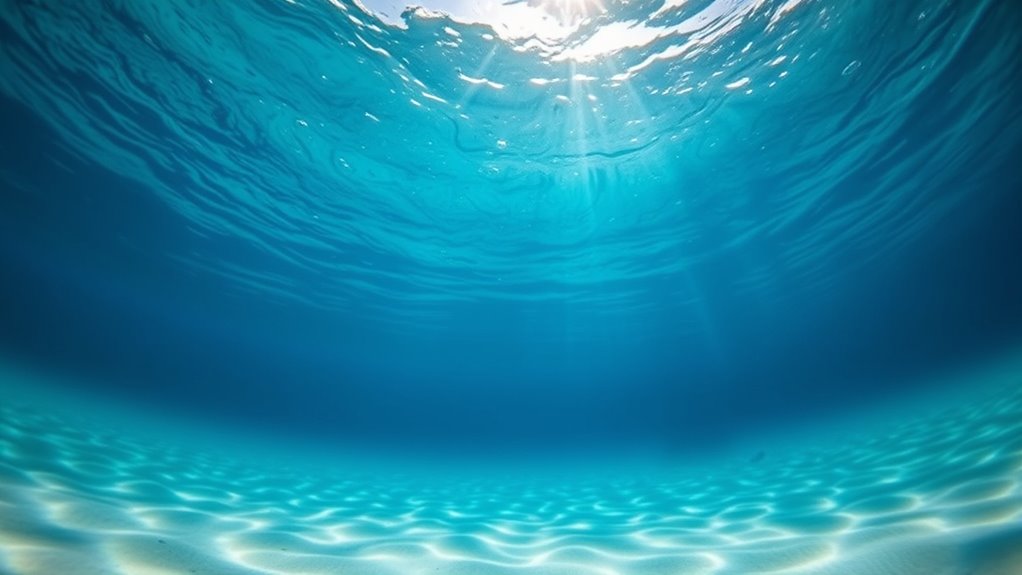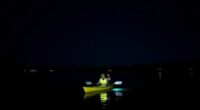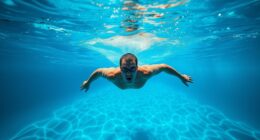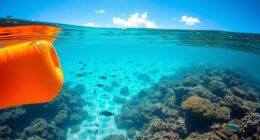To estimate the depth below you while floating, look at nearby objects like rocks, plants, or submerged structures to judge size and clarity; larger or clearer objects suggest shallower water, while small or hazy ones indicate greater depth. Observe how water ripples or sunlight distort these objects, as increased distortion points to deeper areas. Notice movement—objects closer sway more, helping you gauge distance. Understanding how light refraction affects visibility also improves your estimate. If you keep exploring, you’ll find even better ways to judge water depth.
Key Takeaways
- Observe nearby objects like rocks or plants; larger or clearer objects suggest shallower water.
- Compare the size and clarity of floating objects; smaller or hazier ones indicate greater depth.
- Note water surface ripples and light distortion; increased distortion implies deeper water.
- Watch for object movement; closer objects sway more relative to water currents.
- Consider light penetration and shadows; faint light and minimal shadows suggest deeper water.
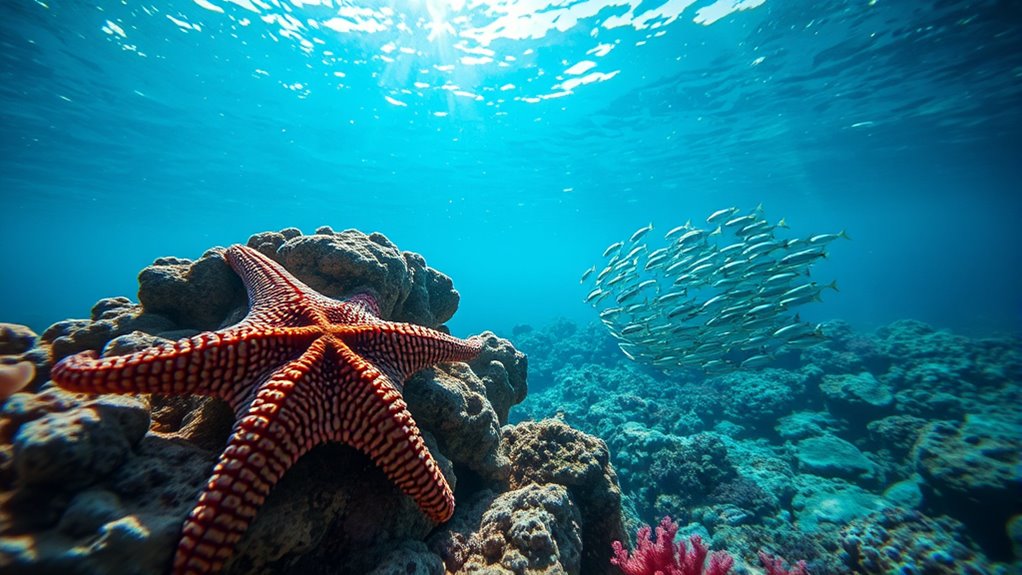
Have you ever wondered how swimmers or divers determine their depth while floating? It’s a question that often comes up when you’re trying to gauge how deep the water is beneath you, especially when you don’t have access to specialized equipment. One of the most effective methods involves observing visual cues and using objects around you to make an educated estimate. When you’re floating in the water, your eyes become your primary tools for evaluating depth, especially if you’re near the surface or in an environment with identifiable objects.
Start by paying close attention to your surroundings. If there are objects like rocks, plants, or submerged structures nearby, these can serve as reference points. For example, if you see a rock or a piece of debris resting on the bottom, compare its size and appearance to objects at the surface or to your hand’s size. If the object appears small or blurry, it indicates greater depth, since water causes light to bend and reduces clarity as the distance increases. Conversely, if the object looks relatively clear and close, you can estimate that you’re floating over a relatively shallow area.
Observe nearby objects like rocks or debris; their clarity and size indicate water depth beneath you.
Using objects as visual cues also involves comparing the size of familiar objects at different depths. For instance, if you notice a floating piece of driftwood or a buoy, observe how it looks from your position. If it appears larger or more detailed than it would if it were farther away, then you’re likely in a shallower section. If it’s tiny or hazy, it’s probably much deeper. This method relies heavily on your ability to judge relative sizes and clarity, which can become more accurate with experience.
Another trick is to look for natural features like the water’s surface ripples or the way sunlight interacts with the water. Ripples tend to distort and obscure objects at greater depths, so the more distorted or blurry the objects appear, the deeper you might be. Similarly, sunlight penetration diminishes with depth, so if you notice the sunlight filtering weakly or casting faint shadows, you’re probably floating above a deeper part of the water.
It’s also helpful to note the way objects move relative to each other. If floating objects seem to sway or shift considerably with your movements or with the water’s current, they might be close. If they remain steady or appear distant, they could be much farther away. Additionally, understanding how light refraction affects visibility can improve your depth estimation, as it influences how objects appear beneath the water’s surface. Combining these visual cues with your knowledge of the environment helps create a clearer mental picture of the depth beneath you, even without precise measuring tools.
Frequently Asked Questions
Can I Estimate Depth Without Any Equipment?
Yes, you can estimate depth without equipment by relying on visual cues and your experience-based estimation. Observe the color and clarity of the water—darker or murkier water often means greater depth. Notice the size and detail of objects or structures around you; smaller and less distinct objects are usually farther away. With practice, you’ll develop a good sense of depth, but always stay cautious, especially in unfamiliar or unclear waters.
How Accurate Is Visual Depth Estimation?
Visual depth estimation can be surprisingly accurate, especially with experience and keen observation of visual cues like size, perspective, and motion. You might find that your perception improves over time as you become more familiar with how objects behave underwater. However, keep in mind that without specialized tools, your estimates can still be off by several feet, so always exercise caution when relying solely on your experience-based estimation.
Does Water Clarity Affect Depth Perception?
Water clarity definitely affects your depth perception. When the water is clear, you can rely on visual cues like the bottom’s features and light refraction to estimate depth accurately. However, if the water is murky, poor water clarity makes it harder to see these cues, leading to less accurate depth perception. So, always be cautious when visibility is low, as your ability to judge depth decreases notably.
Can Underwater Sounds Help Estimate Depth?
You can use underwater sounds to estimate depth by listening to how sound wave propagation changes with depth. Don’t let fear hold you back—underwater acoustics reveal that sounds travel differently at various depths, giving you clues about your distance from the surface or bottom. Focus on the clarity and echo of sound waves; sharper echoes suggest closer objects, while muffled sounds indicate greater depths. Listening carefully can be your guide.
How Does Body Position Influence Depth Judgment?
Your body orientation considerably influences how you judge depth. When you tilt or change your position, it alters your visual cues, like the angle of the water surface or nearby objects, making it harder or easier to perceive how deep you are. Maintaining a stable body position helps your brain interpret visual cues accurately, improving your depth estimation. Be mindful of your orientation to avoid misjudging your depth underwater.
Conclusion
Remember, when it comes to estimating depth while floating, practice makes perfect. Trust your senses, use your surroundings, and don’t be afraid to take your time. Just like the saying goes, “A journey of a thousand miles begins with a single step.” By staying calm and observant, you’ll become more confident in your ability to gauge depth. Keep practicing, stay safe, and enjoy the peaceful experience of floating with a little more confidence.

